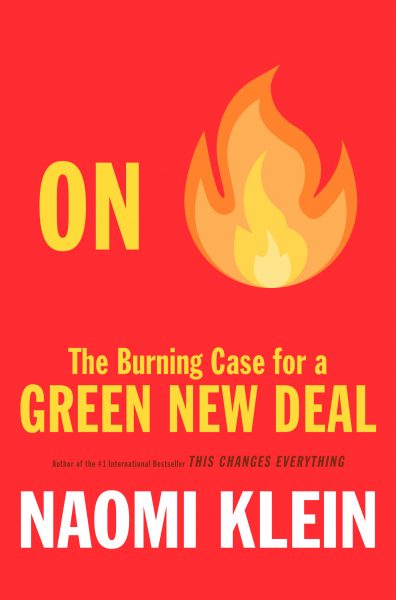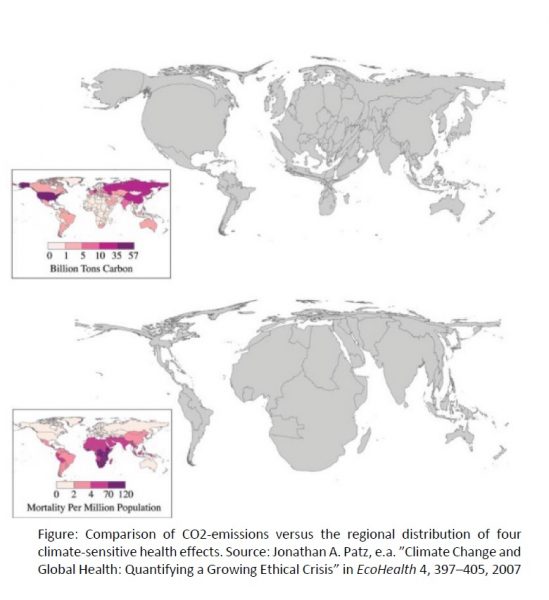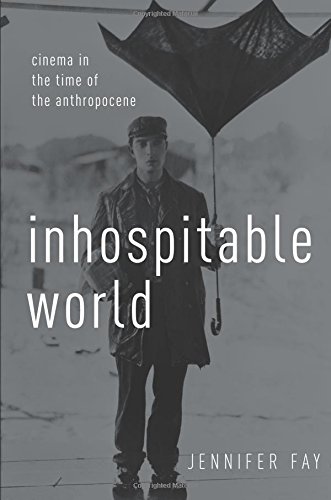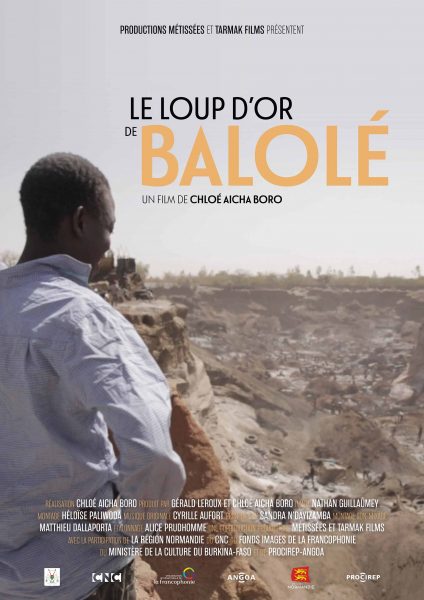by Matthias De Groof
What does global warming have to do with colonialism? The answer is unequivocal: everything. Our efforts for the climate must therefore be decolonial if they are to succeed. After all, taking global warming seriously requires nothing less than changing our colonial relationships with man and nature. Cinema can be at the center of this. Since the populations least responsible for colonial impacts on ecology often bear the greatest costs but are the least heard, any decolonial rethinking of the Anthropocene needs to include experience-based perspectives from the global South. Peoples of the South (and minorities in the North) are not just the prime victims of ecological disasters. Rather, they have developed crucial analyses and resources to challenge environmental racism and build counter-powers. One of these resources is cinema. These cinemas are vehicles of other ecologies of knowledges. But first: what on earth has climate got to do with colonialism?
When on 12 October 2004 in Caracas the bronze statue of Columbus smashes against the ground, it is not only the symbolic destruction of the historical character, but also of what he symbolises: colonialism. Columbus' so-called "discovery" of the "new world" has given rise to two interrelated phenomena: the scientific revolution, which arose from the discovery of Europe's own ignorance; and the profit-driven cycles of colonialism, slavery and extractivism. Needless to say, the first phenomenon was deployed in function of the second. How scientific progress provides both technology and ideological legitimacy to the colonial mercantile enterprise is not the subject of this contribution. However, what is becoming increasingly clear is that this alchemy has greatly influenced our planetary ecology. This will be illustrated by three entanglements between colonialism on the one hand and (global warming as an epiphenomenon of) the Anthropocene on the other hand. Finally, I will briefly discuss space colonisation as a dubious pharmacon to escape from problems on earth that have arisen precisely as a result of colonial practices. Columbus is in the spaceship Columbia, fleeing from what he caused. The name of NASA's spacecraft Columbia OV-102, by the way, is derived from the name of this Italian "explorer".
Entanglement between global warming and colonialism are situated on three levels. The first link between climate and colonialism is historical. Anthropogenic (man-made) climate change is often linked to the industrial revolution, which caused the consumption of coal to skyrocket. While the local impact on the environment and health became apparent almost immediately, it later led to the discovery of the greenhouse effect on a planetary scale. Others reduce it to the "Great Acceleration" in the 1950s: the beginning of an increase in the rate of growth of human activities and corresponding degradation of ecosystems. At the beginning of the 1990s - when capitalism was exported all over the globe - acceleration accelerated. Today, that exponential curve is still rising. Both the Industrial Revolution and the "Great Acceleration" are seen as the cradle of a new geological era, in particular the Anthropocene: the period in the history of the earth in which man has a decisive influence on the state, dynamics and future of the earth system, according to the International Union of Geological Sciences. Climate change is only one feature of the Anthropocene, alongside pollution, acidification, desertification, and its effects, particularly on health and migration.
Now, earth scientists Lewis and Maslin convincingly demonstrate that the Anthropocene goes back not only to the Industrial Revolution or the Great Acceleration, but also to colonialism. The impact of colonialism on ecology - think of the connection of two continental ecosystems, the genocides that followed on this "Columbian Exchange", and then large-scale plantations where people were forced into slave labor - was so great that it left its mark in geological sediments. Europe's colonisation project, according to Lewis and Maslin, marks the beginning of today's globally interconnected economy and ecology, which has set the earth on a new evolutionary path. Colonialism marks the transition to a profit-driven way of life, and a decisive change in Homo sapiens' relationship to nature, one that must pay off. In a narrative sense, Lewis and Maslin write further, climate change began with colonialism and slavery: it is a story about how people interact with the environment and how people interact with each other.

Jacket for Klein's book.
Thus there is not only a historical but also a substantive entanglement of climate change and colonisation. The causes of climate change are linked not only to the history of colonialism, but also to its logic of exploitation and the idea that nature is at our disposal without limits. Alexander von Humboldt (1769-1859) already made the link between colonialism and the destruction of the natural environment and saw colonialism and slavery as two sides of the same coin: the exploitation of nature and man as a means, not an end, and denying the ecology that everything is connected to everything (Wulf 2017:142). The colonisation of nature required theories that normalised the continual exhaustion of nature as an asset, similar to racial theories that justified the colonisation of man, according to Naomi Klein in her book on On Fire. The Burning Case for a Green New Deal. Leaders like Amilcar Cabral and figures like Thomas Sankara also saw these parallels, and consequently integrated an ecology as part of the anti-colonial struggle.
The third link between climate change and colonialism, in addition to the historical and substantive, is symptomatic. The consequences of climate change (and in particular the unwillingness to do something about it) are indeed felt along geopolitical (post)colonial lines, by those who are least responsible for them. Indeed, political inertia prevails in the global North because the consequences are still largely felt by the 'others' in the global South. While climate ambitions may meet Western concerns, they are far from sufficient to prevent humanitarian disasters in the South (World Bank Group. 2013). The conditional tense according to which global warming could have consequences is in many places already far from our bedside, and reveals a geographical bias. Political laziness is a form of "environmental racism" that immediately leads to what UN rapporteur on Extreme Poverty and Human Rights Philip Alston calls "climate apartheid" (see also Jones 1975). In essence, climate refugees are political refugees, because the choice of whether or not to do something about the causes of flight is political. This has far-reaching implications.

Finally, climate change provides a justification for the colonisation of space. It is no coincidence that contemporary Science Fiction is often dystopian when it comes to the environment (many so-called Cli-Fi's); and that in the very beginning of film history, space was an allegory for colonisation, pushing back frontiers and dominating the other. Think, for example, of Voyage dans la Lune by Georges Meliès from 1902, where a number of scientists occupy the moon. After a genocide, one of the lunar survivors clings to the rocket and is exhibited on Earth as was customary with colonised peoples during the world exhibitions. But Space-colonisation is not just Science Fiction. It is mostly (privatised but publicly funded) science, led by people like Elon Musk (Space Exploration Technologies Corp - known as SpaceX) or Jeff Bezoz (Blue Origin). There is no democratic debate about its desirability, but is a colonisation that - like Leopold's Free State or the East India Company - is only accountable to "shareholders". Space colonisation is not a big step for mankind, but it is a big step for Plutocracy. Moreover, it uses the same colonial Cowboy white male hetero-normative border rhetoric, including the myth of the technofix and grandiose morality. "For the good of mankind" is now "saving mankind" (Steven Hawking, Jeff Bezoz ).
The story of the spaceship Columbia from NASA, which has now largely been privatised, is telling. During its launch on 16 January 2003, a piece of foam insulation broke off from the external tank of the Space Shuttle; and damaged the orbiter's left wing. When the spacecraft Columbia re-entered Earth's atmosphere on February 1, 2003, the damage allowed hot atmospheric gases to penetrate the heat shield and destroy the internal wing structure, making the spacecraft unstable and disintegrating. All seven crew members stopped breathing. The Columbia smashed against the ground. The only thing that survived in the debris of the Columbia were the worms (caenorhabditis elegans) that were on board for experiments on the effect of weightlessness on muscle development. Columbia is reminiscent of Icarus' attempt to escape the labyrinth, and calls for decolonial humility.
According to the definition of the Anthropocene (itself a colonial concept, because the mainly Western responsibility for climate change is universised to the "Anthropos", all humanity), we also have a decisive influence on the future of the earth system. If we act quickly and thoroughly, that future may be more favourable than what science predicts with a status quo. However, the efforts will have no chance of succeeding if we do not take into account the frequent links between climate and colonialism. Taking climate warming seriously requires nothing less than changing our colonial relationships with man and nature. The struggle for a liveable planet therefore requires the decolonisation of these relationships. Not domination, but humility. Essential here are the perspectives of those who today are in the first line of experiencing colonised nature, such as the voice of indigenous peoples in cinema. We will therefore have to continue to understand the colonial strategies that dehumanise these populations.
This truly decolonial struggle shows that the problem was never just a climate problem, but one of human relationships. Progress can never be the colonisation of the future. By colonisation of the future, I don't just mean the colonisation of space. In the end, space colonisation turns out to be only a way to escape from problems on earth created by colonial practices (the other three relationships). By colonisation of the future I also mean the fact that today we deprive future generations of the possibility to decolonise our relationship with nature.

Jacket for Fay's book
Now, let us turn to cinema and its ability to address this decolonial challenge. It is no incident that the two major iconographic motives of the Anthropocene – the factory and the train – figure in the early cinema of the Lumière Brothers: Workers Leaving the Factory (1895) and Arrival of a Train at Ciotat (1895). There is increasing interest in reading cinema as cinema about the Anthropocene, but as Jennifer Fay and others such as McKenzie Wark note: perhaps cinema is not just about the Anthropocene, but of it, being a product of the industrial revolution: an Anthropo{mise-en-s}cène. Jennifer Fay’s Inhospitable World: Cinema in the Time of the Anthropocene (2018) helps integrate the concept of the Anthropocene into the field of Cinema Studies, probing the nexus where human-driven climate change meets film theory and aesthetics. She proposes very intriguing and convincing analogies between film and the Anthropocene. Cinema uncannily defamiliarised the world, all the while serving as a tool for the desire to master time, space, nature and life. The names of the precinematic devices (Zoopraxiscope, Zoetrope, Kinetoscope, Mutoscope, Vitagraph, Vitascope...) attest to this. “The Anthropocene is to natural science what cinema [...] has been to human culture”. Cinema creates and represents anthropogenic environments, often as an unintended consequence of human activity. In doing so, cinema has served, in Fay’s words, as “the aesthetic practice of the Anthropocene” (2018:4). Its dominant mode is “aesthetic worldmaking” (2018:4).
Cinemas from the global South and Indigenous cinemas gain new relevance in the context of Anthropocene critique. Through cinema, the global South offers the potential for non-Eurocentric alternatives to dominant interpretations of the Anthropocene. Several communities in the global South turn to film because this medium allows them to use it as a means of advocacy. Furthermore, films as primary vehicles of both reality and imagination are mobile, can reach potentially vast audiences, have the capacity to influence, and are broadly accessible. They are relatively democratised at the level of audience reception as well as the level of production. Just as important, such imaginative work has the capacity to facilitate changes in perspective and to induce empathy through identification. Most importantly, these socio-ecological films address the fact that it is inaccurate to categorise climate change as an environmental problem. Climate scientists can collect and analyse data, they can explain causes and effects, they can even make predictions; but what they cannot do is ‘solve’ climate change, precisely because environmental problems are not natural problems – rather they are cultural or societal justifications for shaping the world (Hanno and Shia Su, 2019). Indeed, as many post-development scholars (e.g. Escobar 2012) have emphasised, tackling the potentially catastrophic effects of the Anthropocene is a matter of culture in which a key role is played by the imagination. As Amitav Ghosh (2016) suggests, the current climate crisis is also a crisis of culture, and thus of the imagination. This imaginative failure, which has been long in the making, urges us to look for alternative ways of imagining the world.

Poster for Le Loup d'or balole
By no means, there is a set of definitive imaginaries that question, challenge, debate, confront, denounce, oppose and contest the colonial Anthropocene. By means of ending this article, I will describe some films I have seen during the last FESPACO, the Panafrican Film Festival in Ouagadougou, Burkina Faso. The Burkinabe film Le loup d'or de Balolé by Aïcha Boro Leterrier shows how the fate of the "wretched of the earth" (les damnés de la terre, as Franz Fanon called them) is linked to the "wretched earth". In the midst of Ouagadougou is hidden a mine. One of the only signals betraying the existence of the mine is the toxic gas escaping from it. "The only bridge to that other planet [a neighbourhood], is our sweat that allows them to build their houses," says a worker. The mine is a stone mine where workers, from toddlers to the elderly, break stones in a post-apocalyptic and polluted landscape that symbolises the Anthropocene. Fires heat up the stones for days, so that they can be broken more easily afterwards. They also break their bodies. The imagination, however, is not yet broken. A little boy imagines a stadium. The stone that shoots loose under his hammer is a soccer ball. Goal! Another one hopes one day to live in a house made out of his stones. A lady even appreciates the aesthetics of the stones she shatters. For others, reality is so crushing that there is no room for hope. Until they take part in the uprising against Blaise Compaoré. Partly thanks to the miners, this uprising has succeeded. The revolt gave them an awareness to continue to change the mine itself, to challenge the hierarchy and to become owners of their own labour. After all, the mine belongs to everyone and no one. This victory enabled some children to go to school hoping to escape the mine. However, what the school books teach is the ideology of "progress" which is partly responsible for the Anthropocene in which they live. The teacher asks out loud: 'do chemical and nuclear weapons contribute to mankind? Despite Blaise Compaoré's departure and change of power, nothing changes. The mine remains legally non-existent and is forgotten. The workers are ghosts of their own existence. The only independence we have,' says a worker, 'is from ourselves'. Their lives do not belong to them and the mine is a prison. Why are they doomed and not the film crew? Our genes do not predetermine us more than yours to be in this mine,' someone says to the cameraman, and thus to the viewer.
This inequality also forms the basis of Silas Siakor's indignation in Silas by Hawa Essuman and Anjali Neyar. This documentary tells the story of environmental activist Silas Siakor who exposes illegal deforestation in Liberia and corruption with the help of an army of volunteers armed with smartphones and the app TIMBY. Large-scale deforestation financed the arming during the Liberian civil war, but did not stop after Ellen Johnson Sirleaf took power. In exchange for the plundering of the forest, the Liberian under Charles Taylor's rule endured civil war, and the Liberian under Sirleaf became dependent on palm oil plantations that swallow forest and villages in favor of "the market". In collaboration with the government, multinationals are taking large tracts of land from forest-dependent communities, both spiritually and economically. Silas defends these communities and their ancestral land before the tribunal which, however, is controlled by logging companies. The dispute results in the militarisation of the sector. This shows the failure of the whole system. Health care is also a victim of corruption, and Ebola easily gains a foothold. The corpses are dropped in the deforested community land. Silas fights for his community, but globally the preservation of the forest is also crucial. Because of its capacity to absorb CO2, the forest is a factor in the global ecological balance and buffer against global warming. Forest logging accelerates global warming and this in turn reduces the storage capacity of trees. Silas' struggle is thus a global struggle for universal heritage.

Film poster "On a le temps pour nous"
Films such as Tesfaye (Ethiopia, Daniel Negatu), Dawa, l'appel à Dieu (Malick Konate, Mali) or On a le temps pour nous(Katy Lena Ndiaye) are about migration, religious fanaticism or political rebellion, and can be related to poverty caused by, among other things, global anthropogenic factors. Solaire Made in Africa (Niger, Sauguirou Malam), seeks solutions. A special film I want to end this article with is Pas d'or pour Kalsaka by the Burkina Faso Michel K. Zongo. A British company wins a contract to industrially mine gold from the soil around the town of Kalsaka. The hill where rites, sacrifices and incantations were to bring health, prosperity and rain, has been razed. Farmland and drinking water have been poisoned. The greatest riches - earth and water - from which the communities have lived for centuries, have been destroyed within five years. The forest and its wildlife disappeared, as well as work, health and food. "The earth belongs to our ancestors. The white man comes and we become beggars". In exchange for 18 tons of gold that the British company officially declared, the community was given a desolate landscape, a great void, anxiety and a deep loss of identity and dignity.
In spite of their diversity, all these films show the unsustainability of the exploitation of natural resources, explicitly show the ecological consequences of a non-circular economy and demand respect for local and often traditional views that radically contradict the interests of mining companies, but are often in line with common and global interests.
About the Author
Matthias De Groof is a postdoctoral researcher affiliated with the Waseda University in Tokyo and the University of Antwerp. He has held visiting fellow appointments at the New York University (Tisch School of the Arts) as a Fulbright and BAEF scholar; the Helsinki Collegium for Advanced Studies with the KONE-Foundation; and the Africa Multiple Cluster of Excellence of the Bayreuth University in Germany. He has Master’s degrees in Philosophy (HIW - KU Leuven), International Relations (UC Louvain), Cinema Studies (University of Antwerp) and African Studies (Uganda Martyrs University). After his PhD in Cinema Studies on African cinema, he worked on postcolonial film theory as a postdoctoral fellow of the Research Foundation Flanders (FWO). At the University of Antwerp, he taught the courses ‘World Cinema,’ ‘Aesthetics,’ and ‘Curating & Exhibiting’. His scholarly work has been published by Third Text, Cambridge Scholars, Columbia University Press, Visual Anthropology, Francofonia, Imaginations, Journal of African Cinema, Image [&] Narrative, Artl@s Bulletin, Ethische Perspectieven, Black Camera, L'Harmattan, Sternberg Press and Wallflower Press.
References:
Schlereth, Thomas J. "Columbia, Columbus, and Columbianism" in The Journal of American History, v. 79, no. 3 (1992)
Wulf, Andrea. De uitvinder van de natuur. Het avontuurlijke leven van Alexander von Humboldt. Atlas Contact 2017
World Bank Group. 2013. What Climate Change Means for Africa, Asia and the Coastal Poor. 19/6/2013. http://www.worldbank.org/en/news/feature/2013/06/19/what-climate-change-means-africa-asia-coastal-poor Accessed 15/10/2018.
Jones, Terry. Apartheid Ecology in America. In Black World. 1975. P4-17
Fay, Jennifer. 2018. Inhospitable World: Cinema in the Time of the Anthropocene. Oxford: Oxford University Press, 2018.
Wark, McKenzie. 2014. “Anthropo{mise-en-s}cène", in Public Seminar, 10/12/2014. vhttp://www.publicseminar.org/2014/12/anthropomise-en-scene/. Accessed 15/10/2018.
Ghosh, Amitav. 2016. The Great Derangement: Climate Change and the Unthinkable. University of Chicago Press.
Su, H. & Su, S. 2019. Why Solving Intergenerational Injustice through Education Does Not Work. On Education. Journal for Research and Debate.
Escobar, A. 2012. Encountering Development : The Making and Unmaking of the Third World. Princeton University Press.